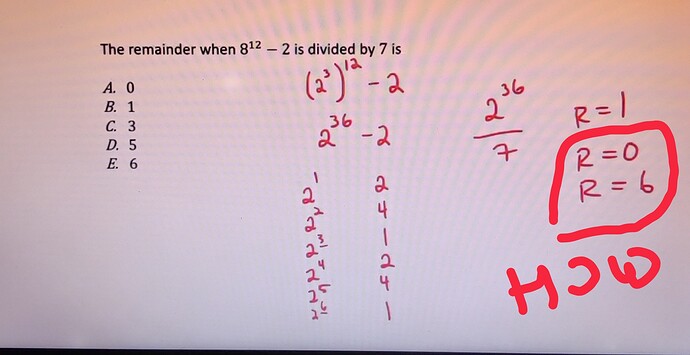what is your doubt ?
idk how to solve this i first thought to break it up like 2^36-2 and then 2(2^5-2) but it was not that much helpful
(1+7)^12 - 2
how can we divide every thing by 7
because (1+7)^12 don’t we need to solve the exponent and the remainder should be -1 and mode of that will be +1 and the official ans… is 6 ???
i just don’t get it can you plz. explain this
My second post explain how we got 6 and evenly distributing seven is same as (3+2)/7 = 3/7 + 2/7
pattern (8^n-2)/7 has a reminder for 6 all integer n>1
Try this way:
8-2 = 6/7 remainder = 6
64-2 = 62/7 remainder = 6
512-2 = 510 remainder = 6
…
and so on
so 8^12 - 2 = Something/7 remainder = 6

Please help me solve this.
Now, distribute the 7 evenly across and calculate the remainders
1/7 → remainder = 1
7/7 → remainder = 0
-2/7 → remainder = -2
Adding them all we get remainder = -1 (but remainder cannot be negative) hence,
-1 = -1 x 7 + 6 (remainder = 6)
If you get negative remainders, just add the divisor to it
In this case, -1 + 7 = 6 is the answer
Try to come up with a pattern
(8^1) - 2 = 6 Remainder =6
(8^2) - 2 = 64-2 = 62 Remainder = 6
(8^3)-2 = 512 - 2 = 510 Remainder = 6
Hence, we can see that the remainder is always 6. You can try checking for powers 4,5,6 and so on and you’ll get the remainder as 6. Hope this explanation helps.
is this true for all remainder qs?
Yeah, remainder is always positive in GRE.
\text{If an integer n is divided by a non-zero integer d resulting in a quotient}\ q \text{ with remainder }\ r,\text{ then}
Official definition provided of remainder via ETS
Hello ,
In the solution of this particular question , I understood till the point we get the remainder “1” when 2^36 is divided by 7
But after that , how do we solve for the " - 2" ?
I didn’t understand the part marked in the ss
So you can actually approach it this way. Instead of finding the cyclicity of the remainers for power of 2s, try finding it for (powers of 2) - 2. So it goes like
2-2 = 0 => remainder 0 when divided by 7
4-2 = 2 => remainder 2 …
8-2 = 6 => remainder 6…
16-2 = 14 => remainder 0…
So it’s 0,2,6,0,2,6…
Or
In the solution you get, the remainder is 2, 4, 1,2,4,1… and so on. So if you subtract 2, you get 0, 2 and 1-2 = -1 (a negative remainder? whut? I’m guessing this is your doubt).If you get a negative remainder, just add the divisor to the remainder. For example. if 8 is divided by 7, remainder is 1. but when 8-2 is divided by 7, we assume the answer is 1-2 = -1. But we know that 8-2 is 6 and 6/7 will give a remainder of 6. And so is -1 + 7 (adding divisor to the negative remainder)
Why this works is because you’re determining how far the dividend is from the nearest multiple of 7 when you say some number is a remainder. If the remainder is 3, you’re saying that the number is 3 units greater than (to the right of) the nearest multiple of 7. So if the remainder is -1 you’re basically saying the number is 1 unit less than (to the left of) the nearest multiple of 7.
Awesome thanks.
That was the exact doubt I was looking the answer for
Is this always true?

